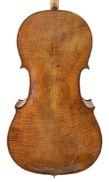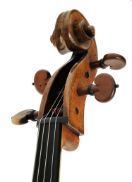Violoncello, Andrea Amati, Cremona, late 16th century
Printed label (not original): “Andrea Amati in / Cremona M. D. LXXIII”Andrea Amati is likely to have been the first Cremona-based violinmaker to have built the bodies of his instruments using an inner mold, a technique in use to this day: The ribs are bent, assembled and clamped around the mold and are glued together to make a rib garland. In this way, all instruments built with an inner mold are certain to have the same contours. During the Baroque period, the length and width of string instruments often varied considerably. Especially violoncellos often had bodies that were several centimeters longer than the present-day standard. The larger body produced a very rich sound above all in the low range, but made technically difficult passages harder to play. Therefore, many cellos were modified starting in the 19th century – the body was cut down to today’s length standard. This Amati cello also shows evidence of such a modification.
Many stylistic characteristics point to Amati as the maker of this cello. It is strongly arched, with the back displaying markedly higher arching than the belly. The spruce belly is made of four pieces with broad, added wings. The wood has a very regular grain and medium-wide annual rings. While the divided, slab-cut back has faint flames, the ribs show more vivid flames. The steep f-holes have larger upper eyes than lower ones, which gives the instrument its typical appearance. The Amati-style pegbox and scroll were added at a later date. The body’s golden-yellow ground is coated with a color varnish that has a pronounced craquelure texture. The varnish of the pegbox and scroll does not fully match the varnish of the body.





